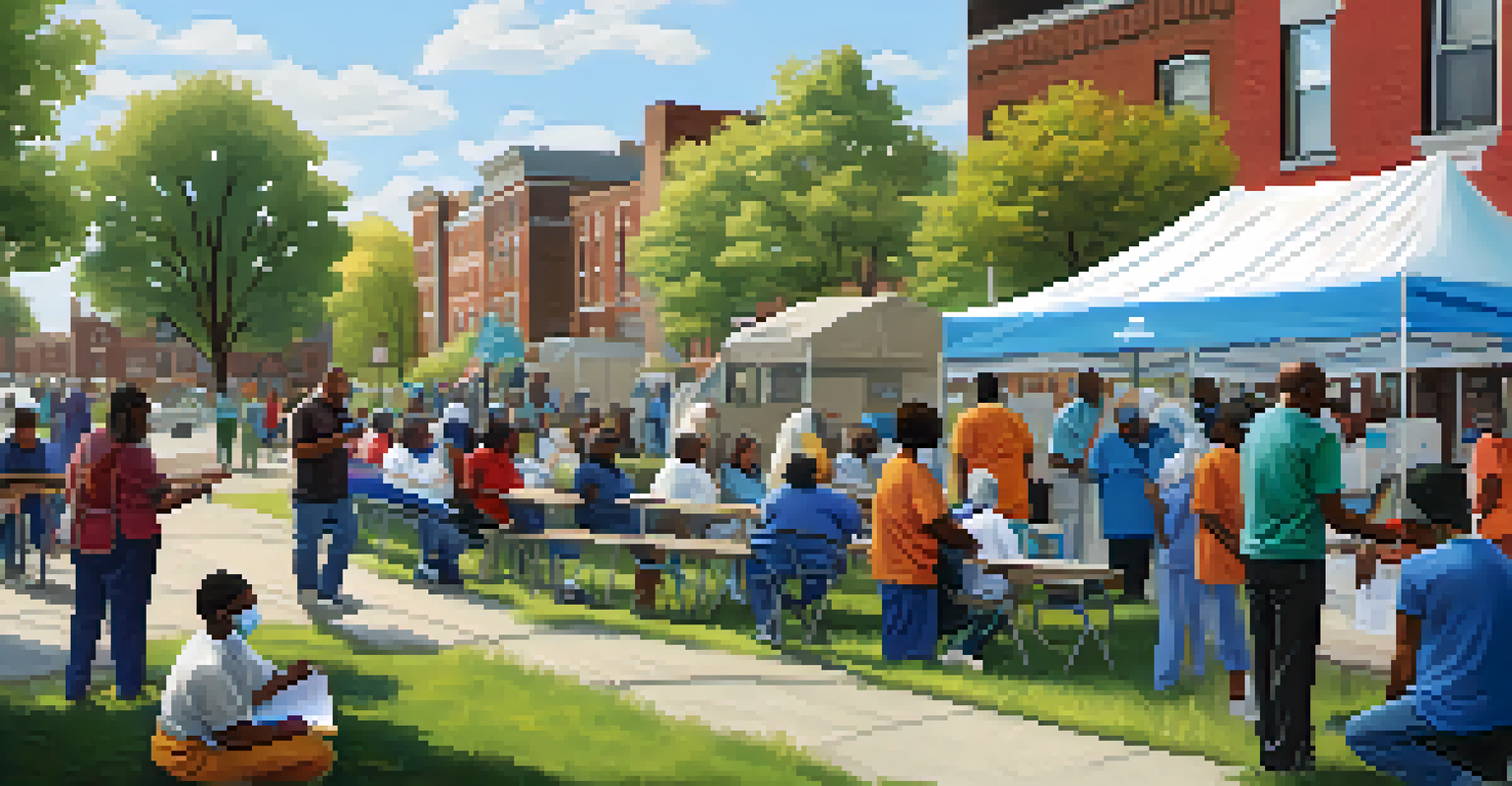Healthcare Strain: COVID-19 and Detroit's Medical Resources

The COVID-19 Surge: A New Challenge for Detroit's Healthcare
When COVID-19 hit, Detroit's healthcare system faced an unprecedented challenge. Hospitals were suddenly inundated with patients, many severely ill and requiring intensive care. This surge not only strained resources but also tested the resilience of healthcare professionals across the city.
The greatest challenge in communication is the illusion that it has been accomplished.
The sheer volume of patients led to shortages in critical supplies like ventilators and personal protective equipment (PPE). Healthcare workers found themselves on the front lines, often working long hours with limited resources and increasing stress. Each day brought new challenges, as they navigated the complexities of this novel virus.
As the city adapted, it became clear that the pandemic exposed underlying issues within the healthcare system. From staffing shortages to funding gaps, the strain of COVID-19 highlighted the urgent need for reforms to bolster Detroit's medical infrastructure for future crises.
Impact on Hospitals: Overcrowding and Resource Allocation
Overcrowding became a defining feature of Detroit's hospitals during the pandemic. Many facilities reached or exceeded their capacity, forcing administrators to make difficult decisions about patient care and resource allocation. The situation required a delicate balance between providing quality care and managing scarcity.

To cope with the influx of patients, hospitals implemented triage protocols, prioritizing those with the highest chances of survival. This process, while necessary, weighed heavily on healthcare providers, who were often faced with moral dilemmas. The emotional toll of such decisions added to the already high levels of stress experienced by medical staff.
Healthcare System Faced Severe Strain
The COVID-19 pandemic exposed critical vulnerabilities in Detroit's healthcare system, highlighting shortages in resources and staff.
In response to these challenges, hospitals sought innovative solutions, such as converting spaces to accommodate more patients. The collaboration between different medical facilities and local government became crucial, as they worked together to share resources and distribute care effectively.
The Role of Community Health: Bridging Gaps in Care
Community health organizations played a vital role in addressing the healthcare strain in Detroit. These local entities stepped in to provide essential services, from testing and vaccination to mental health support. Their grassroots approach helped bridge gaps in care during a time when traditional systems were overwhelmed.
In the middle of difficulty lies opportunity.
By mobilizing volunteers and utilizing telehealth, community organizations reached populations that might otherwise have been neglected. This proactive stance was crucial, especially for vulnerable communities disproportionately affected by the pandemic. Their efforts highlighted the importance of accessible healthcare for all residents.
Furthermore, these organizations fostered trust within the community, encouraging individuals to seek care and adhere to public health guidelines. This relationship between community health and residents became a lifeline, emphasizing that collective action is vital in overcoming public health crises.
Telehealth Expansion: A Lifeline During COVID-19
The pandemic accelerated the adoption of telehealth services across Detroit. As in-person visits became risky, many healthcare providers turned to virtual consultations to maintain patient care. This shift not only ensured continuity of care but also made healthcare more accessible for many residents.
Patients appreciated the convenience of accessing medical advice from the comfort of their homes. For those with mobility issues or limited transportation options, telehealth offered a much-needed solution. However, it also highlighted the digital divide, as not everyone had equal access to the necessary technology.
Community Health Organizations Key
Local health organizations played a vital role in bridging care gaps and ensuring access to essential services during the pandemic.
As we move forward, the lessons learned from telehealth during the pandemic can inform future healthcare practices. Continued investment in digital infrastructure and training for both providers and patients will be essential to ensure that telehealth remains a viable option beyond the crisis.
Mental Health Crisis: Addressing the Hidden Toll of COVID-19
The mental health impact of COVID-19 has been profound, particularly for healthcare workers and patients alike. The stress of dealing with a pandemic, combined with the grief of losing loved ones, has led to a surge in anxiety and depression. This hidden toll often goes unnoticed, yet it’s critical to address.
Healthcare professionals faced not only the physical challenges of treating patients but also the emotional burden of witnessing suffering daily. Burnout rates soared, and many sought help to cope with the overwhelming stress. This situation underscored the need for mental health resources within the healthcare system itself.
Community initiatives aimed at providing mental health support became crucial during this time. Programs focused on resilience-building and peer support offered a way for individuals to share their experiences and find solace in a collective struggle. Prioritizing mental health is essential for recovery and future preparedness.
Vaccine Distribution: Challenges and Triumphs in Detroit
As vaccines became available, the race to distribute them across Detroit presented both challenges and triumphs. The logistics of administering vaccines to a large population required careful planning and collaboration among various stakeholders. This was especially important in a city where access to healthcare can vary significantly.
Community health organizations played a pivotal role in ensuring equitable vaccine access. They organized pop-up vaccination clinics and outreach efforts to educate residents about the importance of getting vaccinated. These initiatives were essential in combating vaccine hesitancy and ensuring that vulnerable populations received protection against the virus.
Telehealth Became Essential Resource
The surge in telehealth services during the pandemic provided a crucial alternative for patient care while revealing disparities in technology access.
The success of the vaccination campaign highlighted the power of community engagement in public health efforts. By building trust and addressing concerns, Detroit made significant strides in increasing vaccination rates, ultimately contributing to the city’s recovery from the pandemic.
Looking Ahead: Strengthening Detroit's Healthcare System
As Detroit emerges from the shadow of COVID-19, there's a crucial opportunity to strengthen its healthcare system. The pandemic exposed vulnerabilities that need addressing, from resource shortages to mental health support. A comprehensive approach is necessary to build a more resilient and equitable healthcare landscape.
Investment in infrastructure, including hospitals and community health organizations, will be vital in preparing for future health crises. Policymakers must prioritize funding and resources to ensure that all residents have access to quality care, regardless of their circumstances. Collaboration between public and private sectors will be essential.

Ultimately, the lessons learned during the pandemic can guide future healthcare strategies. By fostering a culture of preparedness and adaptability, Detroit can emerge stronger, ensuring that its healthcare system is equipped to handle whatever challenges lie ahead.